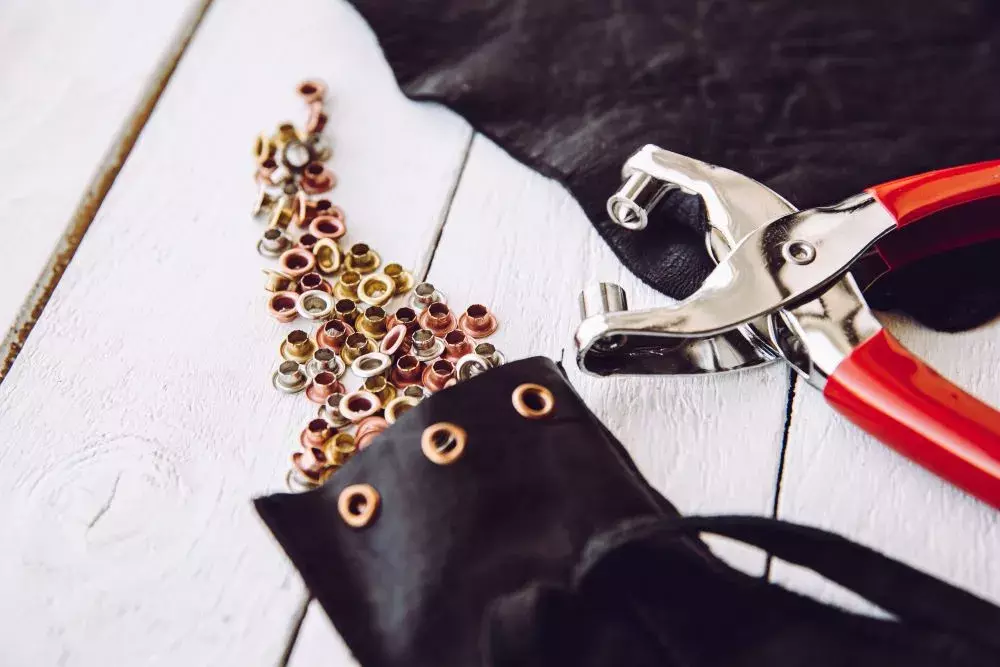Grommet Pliers: Why They Are a Necessary Tool
2023-09-05
If you’ve ever examined a quality pair of boots, corsets, or a tarp, you most likely noticed that the laces passed through small metal reinforcement rivets. These rivets, called grommets, prevent the material from fraying or tearing from tension and friction.
There are many sizes of grommets, from ¼” to 1”, with the most common being ¼” and ⅜.” The right diameter will be determined by the size and purpose of the garment, tent, tarp, etc., as well as the size of the ribbons, laces, or ropes you plan on using.
No matter what size you will use, you will need special grommet tools to install them, so you should ensure you get the best ones for your applications!
Grommets vs. Eyelets
You have several options for reinforcing the path of laces, with the most common being grommets and eyelets. They perform the same function but are fundamentally different:
- Grommets: Made up of two pieces, specifically an eyelet that fits into a washer
- Eyelets: Made of a single piece that’s compressed to stay in place
Eyelets are typically much smaller than grommets and generally have less variety of material and size. They work by physically deforming during compression to grip the material. Grommets work by linking two separate pieces. They are much stronger than eyelets and require different tools to apply.
Grommet Pliers vs. Other Grommet Tools
The most useful tool for small jobs is grommet pliers. If you’re installing small grommets for a few items here and there, rather than setting up an assembly line, grommet pliers will give you the repeatedly accurate results you want. Let’s go over what the pliers are and some alternatives:
1. Grommet Pliers
Looking like a standard set of pliers with unusually-shaped jaws, grommet pliers combine several different grommet tools into one. The pliers have two jaws:
- A circular mold that fits into the top piece of the grommet
- An anvil on which the mold presses against
By squeezing the pliers, the user applies enough force to combine the two pieces of the grommet.
2. Hammer, Grommet Setting Tool, Anvil
The more traditional set of grommet tools involves multiple pieces. You need a hammer for applying the striking force, a grommet setting tool with a circular mold, and an anvil underneath to withstand the hammer blows and support the grommet.
This is a less portable solution, requires users to be more accurate, and more pieces mean more opportunities for losing one of the tools!
3. Grommet Press
A bench-mounted grommet press is an excellent option if you set up a shop that needs to press dozens or hundreds of grommets daily. However, these generally aren’t meant to be moved around and are intended for bolting to a stationary surface.
Grommet pliers are probably the best option for hobbyists or people who want portability.
Using Grommet Pliers
Before you begin, make sure to match the size of the grommet to the size of the plier jaws. As long as you’ve done this, you’re ready to go! Proceed as follows:
Determine where to install your grommet in the fabric and mark accordingly.
Place the grommet pieces in the plier jaws, with the washer on the bottom.
Line up your pliers and grommet with your marked location on the fabric.
Squeeze!
If you’ve done it right, the pliers will have simultaneously installed the grommet and punched a hole in the fabric. If you think the grommet isn’t set straight, you can rotate the pliers slightly and press again. It’s truly that simple!
Now, you do have to be able to apply enough hand pressure to ensure the grommet pieces are properly joined, which is why this tool is usually reserved for grommets under ½”. If you have particularly thick material, such as leather, you may have to cut a hole before you begin.
Find All the Grommet Tools You Need at GoldStar Tool
Whether you prefer to use quick and easy grommet pliers or an old-fashioned hammer and anvil, or you want to mass-produce garments with grommets, you can find everything you need at Goldstar Tool. Check out our quality offerings and get started crafting today!





